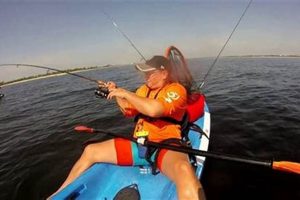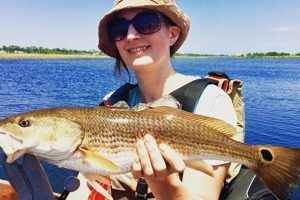Kayak fishing is the practice of angling from a kayak. This method allows anglers access to shallow or otherwise difficult-to-reach waters, offering a unique perspective and experience compared to shore or boat fishing. A typical setup might involve a sit-on-top kayak outfitted with rod holders, storage for tackle and gear, and potentially an anchor or specialized propulsion system.
The popularity of this approach stems from its affordability, versatility, and intimate connection with nature. It offers a low-impact way to explore diverse aquatic environments, from tranquil ponds to open oceans, targeting a wide range of fish species. Historically, kayaks were used for hunting and fishing by indigenous populations. Modern advancements in kayak design and materials have transformed this traditional practice into a widely accessible and popular recreational activity.
This article will further explore various aspects of kayak fishing, including choosing the right kayak, essential equipment, safety considerations, popular fishing techniques, and recommended locations for a successful and enjoyable experience.
Kayak Fishing Tips
Successful kayak angling requires careful planning and preparation. The following tips offer guidance for a safe and productive experience.
Tip 1: Choose the Right Kayak: Kayak selection depends on the intended fishing environment and angler preferences. Longer kayaks offer better tracking in open water, while shorter, wider models provide greater stability in calm waters. Sit-on-top kayaks are generally preferred for fishing due to their self-bailing design and ease of re-entry.
Tip 2: Prioritize Safety: Always wear a personal flotation device (PFD). Carry a whistle, signaling device, and communication equipment for emergencies. Check weather conditions before embarking and inform someone of the planned fishing location and return time.
Tip 3: Organize and Secure Gear: Utilize rod holders, tackle boxes, and dry bags to keep equipment organized and protected from water. Distribute weight evenly within the kayak for optimal balance and stability.
Tip 4: Practice Paddling and Maneuvering: Develop proficiency in paddling and maneuvering the kayak, especially in wind and currents. Practice casting and retrieving from a seated position.
Tip 5: Understand Local Regulations: Obtain necessary fishing licenses and familiarize oneself with local fishing regulations, including size and catch limits.
Tip 6: Respect the Environment: Practice catch-and-release whenever possible. Properly dispose of fishing line and other waste materials to minimize environmental impact.
Tip 7: Learn Basic Kayak Fishing Techniques: Research and practice techniques specific to kayak fishing, such as anchor trolling, drift fishing, and sight casting.
By adhering to these guidelines, anglers can enhance their safety, maximize their fishing success, and contribute to the preservation of aquatic ecosystems.
These tips offer a starting point for exploring the world of kayak fishing. Further research and experience will contribute to a more comprehensive understanding of this rewarding activity.
1. Legality
Legality plays a crucial role in kayak fishing. While the activity itself is generally permitted, specific regulations govern where, when, and how one can fish from a kayak. These regulations vary by jurisdiction and are often tied to conservation efforts, ensuring sustainable fish populations and protecting sensitive ecosystems. Understanding and adhering to these legal frameworks is a fundamental component of responsible kayak angling.
For example, certain areas may be designated as no-fishing zones to protect spawning grounds or endangered species. Specific seasons may be closed for particular fish species to allow for population recovery. License requirements, catch limits, and permitted fishing methods (e.g., types of lures or bait) also fall under the umbrella of legal considerations. Ignoring these regulations can result in fines, confiscation of equipment, and even legal prosecution. Checking with local authorities or consulting online resources specific to the intended fishing location provides the necessary information for compliance. Failure to do so not only jeopardizes the environment but also undermines the angler’s ability to legally participate in the activity.
In summary, legal compliance is not merely a formality but an integral aspect of sustainable and ethical kayak fishing. It safeguards aquatic ecosystems, ensures fair access to resources, and ultimately protects the longevity of the sport. Prioritizing research and understanding of local regulations is paramount for any angler considering kayak fishing.
2. Safety
Safety is paramount in kayak fishing. The inherent risks associated with being on the water, often alone and in remote locations, necessitate a proactive and comprehensive approach to safety measures. Failure to prioritize safety can lead to serious consequences, including injury, loss of equipment, or even fatality. A key component of answering the question “can I fish from a kayak?” is acknowledging and addressing these potential hazards.
Several factors contribute to the safety concerns specific to kayak fishing. Kayaks, being smaller and less stable than traditional boats, are more susceptible to capsizing, particularly in rough waters or strong currents. The angler’s proximity to the water increases the risk of immersion, even in relatively calm conditions. Cold water immersion poses a significant threat of hypothermia, even in warmer climates. Furthermore, the potential for encounters with wildlife, from aggressive fish to marine mammals, adds another layer of complexity to safety considerations. Real-life examples abound of anglers encountering difficulties due to inadequate safety preparation, ranging from minor incidents like losing equipment overboard to more serious situations requiring rescue operations.
Mitigation of these risks requires careful planning and execution. Wearing a properly fitted personal flotation device (PFD) is non-negotiable. Carrying essential safety equipment, such as a whistle, signaling device, and waterproof communication device, is crucial for summoning assistance in an emergency. Checking weather forecasts and understanding potential changes in water conditions are vital for informed decision-making. Informing someone of the planned fishing location and estimated return time provides an additional layer of security. Finally, proper kayak handling skills and knowledge of self-rescue techniques are fundamental for minimizing the likelihood of incidents and maximizing the chances of a safe return. Ignoring these safety precautions undermines the feasibility and enjoyment of kayak fishing, transforming a potentially rewarding activity into a hazardous undertaking.
3. Equipment
Appropriate equipment is fundamental to the feasibility and success of kayak fishing. The selection and utilization of gear directly impact an angler’s safety, comfort, and effectiveness on the water. Addressing the question “can I fish from a kayak?” requires a thorough understanding of the essential equipment and its role in facilitating a positive fishing experience.
- Kayak Selection
The kayak itself forms the foundation of the fishing platform. Choosing the right kayak depends on factors such as the intended fishing environment (calm lakes, rivers, or open ocean), the angler’s physical stature and experience level, and storage capacity requirements. Sit-on-top kayaks are generally preferred for their stability, self-bailing design, and ease of re-entry after a potential capsize. A longer, narrower kayak offers better tracking and speed in open water, while a shorter, wider kayak provides greater stability in calmer conditions. Specialized fishing kayaks often feature built-in rod holders, storage compartments, and anchor systems.
- Paddle and Propulsion
Efficient propulsion is essential for navigating to fishing spots and maneuvering in various water conditions. A properly sized and designed paddle is crucial for effective paddling. Alternatives, such as pedal-powered kayaks or electric motors, offer advantages in terms of speed and hands-free operation, allowing anglers to focus on fishing. The choice of propulsion depends on individual preferences, fishing style, and the specific environment.
- Fishing Gear
Rods, reels, lines, lures, and other fishing tackle are essential components of the equipment list. The specific gear required varies depending on the target fish species and the fishing techniques employed. Rod holders mounted on the kayak allow for convenient storage and access to rods while paddling or maneuvering. Tackle boxes and dry bags provide organized storage and protect gear from water damage. A landing net assists in safely retrieving caught fish.
- Safety Equipment
Prioritizing safety necessitates specific equipment beyond the fishing gear. A personal flotation device (PFD) is mandatory for all kayak anglers. A whistle, signaling device (e.g., flares or a mirror), and a waterproof communication device (e.g., VHF radio or a satellite phone) are crucial for summoning assistance in emergencies. A first-aid kit, knife, and bilge pump are additional safety items that should be included in the equipment list.
The careful selection and proper utilization of these equipment components are inextricably linked to the ability to safely and effectively fish from a kayak. Investing in appropriate gear and understanding its function enhances not only the fishing experience but also the overall safety and preparedness of the angler. The question “can I fish from a kayak?” is answered affirmatively through the availability and effective deployment of this essential equipment.
4. Techniques
Effective fishing techniques are essential for successful kayak angling. The confined nature of a kayak and its proximity to the water require specialized approaches distinct from shore or boat fishing. Understanding these techniques directly addresses the practicality and effectiveness of fishing from a kayak.
- Casting and Retrieving
Casting from a seated position in a kayak requires adjustments to maintain balance and accuracy. Short, underhand casts are often preferred, minimizing the risk of entanglement and maximizing control. Retrieving line requires careful coordination to avoid tipping or losing balance. Practicing these modified casting and retrieving techniques on land before venturing onto the water significantly improves efficiency and safety.
- Drift Fishing
Drift fishing involves allowing the kayak to drift with the current or wind while presenting bait or lures. This technique is particularly effective in rivers or areas with consistent currents. Controlling the drift speed using a drift sock or anchor allows for targeted coverage of specific areas. Maintaining awareness of surrounding obstacles and other watercraft is crucial for safe and productive drift fishing.
- Anchor Trolling
Anchor trolling involves deploying an anchor to hold the kayak in a fixed position while fishing. This technique is advantageous in areas with known fish concentrations, such as near underwater structures or drop-offs. Using a lightweight anchor system and adjusting anchor position based on current and wind conditions maximizes effectiveness. Carefully retrieving the anchor prevents entanglement and ensures a safe departure.
- Sight Casting
Sight casting, or sight fishing, involves visually locating fish and then casting directly to them. This technique requires clear water conditions and keen observation skills. The low profile of a kayak provides a distinct advantage for sight casting, minimizing disturbance and maximizing stealth. Quietly approaching fish and presenting lures with precision increase the likelihood of a successful hookup.
Mastering these techniques significantly enhances the feasibility and effectiveness of kayak fishing. The ability to adapt to the unique challenges and opportunities presented by a kayak platform transforms the “can I fish from a kayak?” question into a confident affirmation of its potential. Practicing these techniques in various environments and refining them based on experience further increases the likelihood of a successful and enjoyable kayak fishing adventure.
5. Locations
Location significantly influences the feasibility and success of kayak fishing. The question “can I fish from a kayak?” depends heavily on the characteristics of the chosen location. Factors such as water accessibility, prevailing conditions, fish species presence, and local regulations all contribute to determining suitable locations. Careful consideration of these factors is crucial for a safe and productive fishing experience.
Calm lakes and ponds offer ideal locations for beginners due to their sheltered nature and predictable conditions. These environments allow novice anglers to develop fundamental kayak handling and fishing techniques without the added challenges of strong currents or waves. Slow-moving rivers also provide excellent opportunities for kayak fishing, particularly for species that thrive in calmer waters. Navigating rivers, however, requires careful attention to current strength and potential obstacles such as submerged logs or rocks. Coastal areas and estuaries present more challenging but potentially rewarding locations. Dealing with tides, currents, and varying water depths necessitates greater experience and advanced kayak handling skills. Open ocean kayak fishing, while offering access to pelagic species, demands considerable expertise and specialized equipment due to the unpredictable nature of the open sea. Examples include protected bays for beginners, river systems for intermediate anglers, and open ocean environments for experienced kayakers.
Understanding the specific characteristics of a chosen location, including its accessibility, prevalent conditions, and potential hazards, is essential for responsible and successful kayak fishing. Evaluating these factors not only enhances the likelihood of a productive fishing trip but also contributes significantly to angler safety. The question “can I fish from a kayak?” is answered affirmatively through careful location selection based on skill level, target species, and the prevailing environmental conditions. Failure to consider location-specific factors can undermine the feasibility and safety of the activity, transforming a potentially rewarding experience into a hazardous undertaking.
Frequently Asked Questions
This section addresses common inquiries regarding kayak fishing, providing concise and informative responses to facilitate a comprehensive understanding of the activity.
Question 1: What type of kayak is best suited for fishing?
Sit-on-top kayaks are generally recommended due to their stability, self-bailing design, and ease of re-entry after a capsize. Specialized fishing kayaks offer additional features like rod holders and storage compartments.
Question 2: Is kayak fishing safe?
Kayak fishing carries inherent risks, but these can be mitigated through proper safety precautions. Wearing a PFD, carrying communication devices, checking weather conditions, and informing someone of fishing plans are essential safety measures.
Question 3: What essential equipment is required for kayak fishing?
Essential equipment includes a fishing kayak, paddle, PFD, fishing rods and reels, tackle, appropriate clothing, safety gear (whistle, signaling device, communication device), and navigation tools.
Question 4: Where can one legally fish from a kayak?
Legal fishing locations vary by jurisdiction. Consulting local authorities or online resources provides information on permitted areas, seasons, license requirements, and catch limits.
Question 5: What are some effective kayak fishing techniques?
Effective techniques include casting and retrieving from a seated position, drift fishing, anchor trolling, and sight casting. The choice of technique depends on the target species and the specific fishing environment.
Question 6: How does one transport a kayak for fishing?
Kayaks can be transported using roof racks, trailers, or truck beds. Securing the kayak properly during transport prevents damage and ensures safe travel.
Careful consideration of these frequently asked questions enhances preparedness and contributes to a safer and more enjoyable kayak fishing experience. Further research and consultation with experienced anglers can provide additional insights and address specific concerns.
Beyond these frequently asked questions, additional resources such as online forums, instructional videos, and local fishing clubs offer valuable information and support for aspiring kayak anglers.
Conclusion
The feasibility of kayak fishing hinges upon a confluence of factors. Careful consideration of legal regulations, adherence to safety protocols, acquisition of appropriate equipment, mastery of specialized techniques, and judicious location selection are all integral components of a successful and rewarding experience. This multifaceted approach transforms a simple inquiry”can I fish from a kayak?”into a resounding affirmation of its potential. Ignoring any of these crucial elements undermines the practicality and safety of the activity, potentially transforming a recreational pursuit into a hazardous undertaking.
Kayak fishing offers a unique and intimate connection with the aquatic environment. Its accessibility and adaptability allow anglers to explore diverse waters and target a wide range of species. However, responsible engagement with this activity necessitates a commitment to continuous learning, adaptation, and unwavering prioritization of safety and environmental stewardship. The future of kayak fishing relies on the collective responsibility of anglers to engage with this activity ethically and sustainably, ensuring its viability for generations to come.






